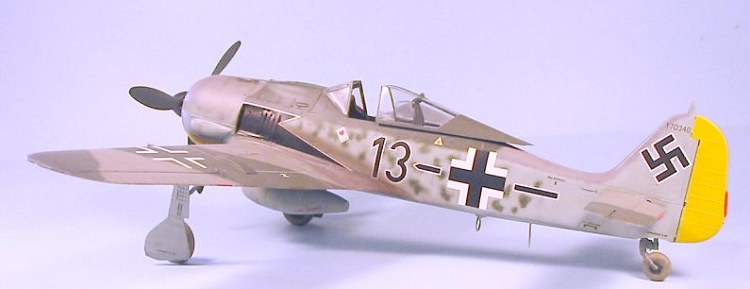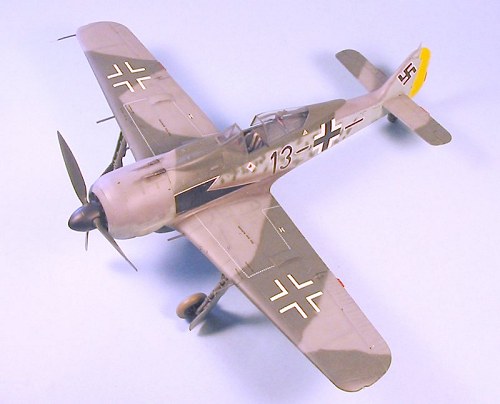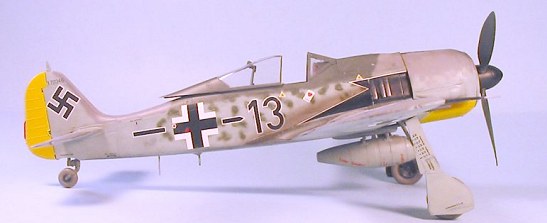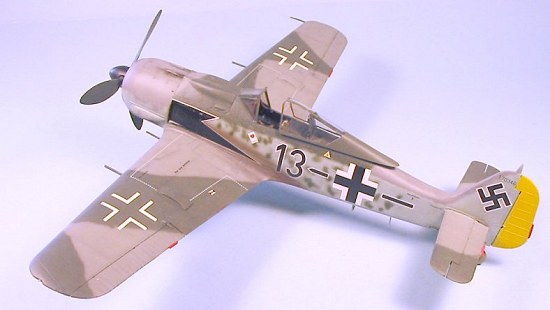
| KIT: | Hasegawa 1/32 FW-190A-8 |
| KIT #: | ? |
| PRICE: | $44.95 MSRP |
| DECALS: | options |
| REVIEWER: | Tom Cleaver |
| NOTES: | Markings from Kagero's Aircraft Aces #2 Monograph |

| HISTORY |
Pips Priller Faces Down The Normandy Invasion:
By the end of May, 1944, JG26 was a much different organization than
it had been at the turn of the New Year. After five months of
increasingly-difficult battles with the 8th Air Force during
Operation Argument - the strategic bombing campaign designed to knock out
the Luftwaffe prior to the invasion of Europe, the Geschwader
had faced increasing numbers of American fighters, particularly the
superlative Mustang. Located as they were at the Western European point of
entry for nearly every 8th Air Force mission against Germany,
the pilots of the three Gruppen flew multiple missions against the
USAAF formations, and suffered attrition accordingly. Many notable
leaders, among them III Gruppe’s Kommandeur “Wutz”
 Gal land -
youngest brother of the redoubtable Adolf - had been lost in the battles,
as well as other experienced Staffel and Rotte leaders. The
new pilots who came to the Geschwader - the Nachwuchs -
suffered from increasingly-abbreviated training and were really not
qualified to go up against their Allied opponents.
Gal land -
youngest brother of the redoubtable Adolf - had been lost in the battles,
as well as other experienced Staffel and Rotte leaders. The
new pilots who came to the Geschwader - the Nachwuchs -
suffered from increasingly-abbreviated training and were really not
qualified to go up against their Allied opponents.
Thus, with a weather forecast for the first week in June that seemed to preclude any possibility of the Allied invasion every German knew would come sooner rather than later that summer, Geschwader Kommodore Oberst Josef “Pips” Priller - the leading German experte on the Channel Front - felt safe in giving some of his pilots time off, sending II Gruppe to Mont de Marsan near Biarritz for a week’s leave. I and III Gruppen, which were based on the Pas de Calais - directly in what it was expected would become the battlefield - were ordered to move inland on June 5, with I Gruppe to be based at Reims and III Gruppe at Nancy; their ground echelons were still on the road as dawn came on June 6, 1944 when Priller was awakened by the phone in his Lille command post.
The orders from 5th Jagddivision were for him to move the Geschwader headquarters immediately to Poix, to the rear of the anticipated invasion site on the Pas de Calais, since what looked like the Allied invasion had begun a few hours ago with mass landings of paratroopers on the Cherbourg peninsula and inland from the Normandy beaches and he needed to move into the combat zone.
The dawn skies were a leaden grey at 0800 as Priller and his longtime wingman, Unteroffizier Heinz Wodarczyk, mounted their two Fw-190A-8s and prepared to take off for a reconnaissance of the invasion beaches. The initial Luftwaffe response to the Normandy Invasion was underway.
 With Wodarczyk sticking close, Priller headed west at an altitude of 100
meters. East of Abbeville, he looked up and saw several large formations
of Spitfires flying through the broken cloud base. Near Le Havre, Priller
climbed into the cloud bank hanging at 200 meters, turning northwest.
With Wodarczyk sticking close, Priller headed west at an altitude of 100
meters. East of Abbeville, he looked up and saw several large formations
of Spitfires flying through the broken cloud base. Near Le Havre, Priller
climbed into the cloud bank hanging at 200 meters, turning northwest.
A few moments later, Priller and Wodarczyk broke out of the clouds, just south the British invasion beach code-named Sword. Priller only had a moment to stare out to sea, where the largest naval force ever assembled in history was just offshore. He could see the wakes of the inbound invasion barges as they approached the beaches for as far as he could see in the hazy weather.
With a shouted “Good luck!” to Wodarczyk, Priller winged over into a dive above Sword Beach, his airspeed indicator climbing above 400 m.p.h. Dropping to an altitude of 50 feet, Priller roared toward Sword Beach, followed closely by Wodarczyk.
British troops dove for cover while the ships offshore opened a barrage of anti-aircraft fire so loud that those on the ground had trouble hearing sound of the 8 20mm cannon and 4 13mm machine guns with which Priller and Wodarczyk opened fire as they flashed overhead, unscathed by the fleet’s fire.
In a moment the only appearance by the Luftwaffe over the Normandy beaches on the first day of the invasion was over, and the two Fw-190s zoomed back into the cloud bank and disappeared. Priller and Wodarczyk had just flown the best-known mission in the entire history of JG 26, due to its later inclusion in Cornelius Ryan’s book “The Longest Day” and the movie made from it.
By that afternoon, I and II Gruppen had flown the majority of the 172 sorties flown by the Luftwaffe in the invasion sector on June 6 - in opposition to the 14,000 sorties flown that day by the Allied Air Forces - while II Gruppe flew across France in time to fly a mission over Normandy in the last light of day, then operated from Guyancourt outside Paris.
 By the evening of June 7, there were only six Jagdgeschwadern in
Germany, with 17 having flown into northwestern France to oppose the
invasion. Had all units been at full strength, this would have been a force
of over 1,000 fighters, which might have had an impact on the battle.
Unfortunately, with the losses suffered over Germany in the preceding
months and the disorganization of the move from Germany to France, only 289
fighters were listed as operational at sundown of the second day of the
invasion. Over the course of the next two months, what was left of the
flower of the Jagdwaffe would die over Normandy, outnumbered by odds of
100:1 and outflown by better-trained and more experienced Allied pilots.
By the evening of June 7, there were only six Jagdgeschwadern in
Germany, with 17 having flown into northwestern France to oppose the
invasion. Had all units been at full strength, this would have been a force
of over 1,000 fighters, which might have had an impact on the battle.
Unfortunately, with the losses suffered over Germany in the preceding
months and the disorganization of the move from Germany to France, only 289
fighters were listed as operational at sundown of the second day of the
invasion. Over the course of the next two months, what was left of the
flower of the Jagdwaffe would die over Normandy, outnumbered by odds of
100:1 and outflown by better-trained and more experienced Allied pilots.
On June 7, Priller scored his 97th and 98th victories, a P-47 and P-51 respectively, while pilots of I and II Gruppen scored 8 for two losses. The next day, after the weather lifted, Priller led a strafing mission of 11 Focke-Wulfs from I Gruppe against the beaches which only scored the “destruction”of 15 crashed gliders. On June 10, Priller scored #99, a P-38 in a low-level dogfight.
On June 12, Priller was ordered to make an early morning sweep northwest of Caen. Leading Fw-190s of II/JG 26 and III/JG 54, and Bf-019s of III/JG 26, Priller was ordered to change course and attack several formations of heavy bombers heading inland.
Priller dove through a formation of B-17s, firing at several to no effect. In the distance he spotted a formation of Liberators and turned toward them.
The B-24s of the 492nd Bomb Group had almost no warning as the German formation roared through them. Priller opened up on the B-24 in the outboard position of the first vee, getting strikes in the cockpit and on the two left engines. He dove away as he saw the bomber fall away from the formation with three engines afire.
 Priller headed inland as the B-24 turned for the beach, straining for
allied territory. Two engines were dead and a third was aflame. As the
third engine failed, the navigator reported they were over allied territory
and bailed out. The pilot held for another few minutes until the fourth
engine quit, and then the rest bailed out. The navigator had gone too
soon, and was picked up by German troops to become a POW, while the others
landed safely behind Allied lines. In a twist of fate, the navigator’s
mistake meant he would survive the war, since the rest of the crew died
three weeks later in a crash back at base.
Priller headed inland as the B-24 turned for the beach, straining for
allied territory. Two engines were dead and a third was aflame. As the
third engine failed, the navigator reported they were over allied territory
and bailed out. The pilot held for another few minutes until the fourth
engine quit, and then the rest bailed out. The navigator had gone too
soon, and was picked up by German troops to become a POW, while the others
landed safely behind Allied lines. In a twist of fate, the navigator’s
mistake meant he would survive the war, since the rest of the crew died
three weeks later in a crash back at base.
The B-24 was Priller’s 100th victory, all scored on the Western Front in the Battle of France, the Battle of Britain, and the Channel Front battles. On landing, his men congratulated him, but he was more interested in the letter from home, in which his wife told him his eldest child would be born in a week. At the end of June, he reported to Hitler’s Wolfschanze to be awarded the Swords to the Knight’s Cross; he was the second and last JG 26 pilot to be so decorated.
Priller scored one more victory at the end of 1944 and survived the war, leaving JG 26 shortly after Operation Bodenplatte to become Inspector of Day Fighters in the West. His record of five years’ continuous combat service on the toughest front of the war was unequaled by any other pilot.
| THE KIT |
There are several reviews in Modeling Madness of Hasegawa’s Fw-190A-8 kit.
| CONSTRUCTION |
 I’ve written several articles here about constructing the kit. The only
“big deal” was to make a modification to the drop tank. JG 26 used a
lightweight rack for their tanks that was considerably different from that
carried by other Fw-190s. I used the drop tank rack in the kit that is a
holdover from the Fw-190D-9 release, cutting it down and trimming it to
look like the lightweight rack. I also used the sway braces for the Dora
that are included on the sprues for attaching the drop tank.
I’ve written several articles here about constructing the kit. The only
“big deal” was to make a modification to the drop tank. JG 26 used a
lightweight rack for their tanks that was considerably different from that
carried by other Fw-190s. I used the drop tank rack in the kit that is a
holdover from the Fw-190D-9 release, cutting it down and trimming it to
look like the lightweight rack. I also used the sway braces for the Dora
that are included on the sprues for attaching the drop tank.
The only aftermarket item used was a set of posable resin 1/32 seat belts from Cutting Edge.
| COLORS & MARKINGS |
 Painting:
Painting:
Priller’s airplane was a standard-issue Fw-190A-8, in 74/75/76 camouflage, which I painted using the new Acrylix paints from Hannant’s. I painted the lower cowling with Tamiya Flat Yellow, since I have had problems about paint lifting from a full masking job with the Acrylix paints. These paints are great when you are doing a freehand scheme, since they dry to the touch within an hour or so. I did some light “fading” to the colors, more for the look of the model than any historical accuracy. Photos of this airplane at the time of the Normandy invasion show it to have been very well-maintained and clean - which one would expect for the airplane flown by the Geschwader Kommodore - so I kept it nice and neat.
Decals:
I used national insignia and stenciling decals from an Aeromaster sheet, and got the personal markings from a sheet in Kagero's Aircraft Aces #2 , which Scott kindly provided for this project. Everything went down under a coat of Micro-Sol with no trouble.
| FINAL CONSTRUCTION |
After giving the model a final coat of Future, I applied exhaust staining with Tamiya “Smoke,” then gave the model two coats of thinned Dullcote and attached the canopy in the open position.
| CONCLUSIONS |
Pips Priller’s Schwarz Dreizehn is one of the most famous Fw-190s. These decals allow a modeler to do this famous airplane with the great Hasegawa kit.
December 2004
Review kit courtesy of my wallet.
If you would like your product reviewed fairly and quickly by a site that has nearly 300,000 visitors a month, please contact me or see other details in the Note to Contributors.